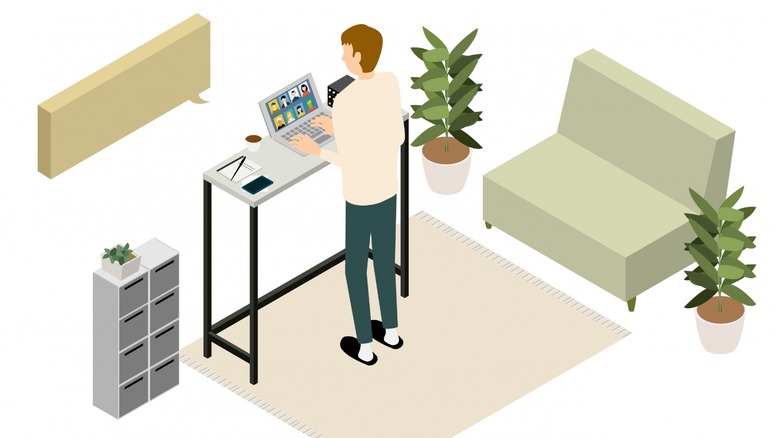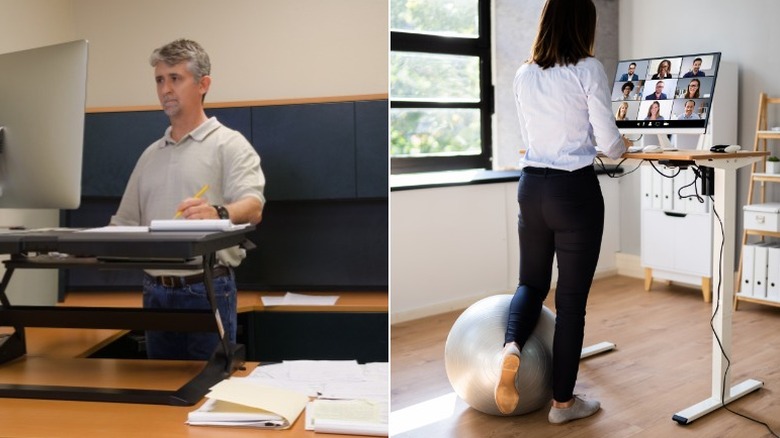What Is The Right Height For A Standing Desk?
Standing desks are a gift to those of us who believe, as Mayo Clinic professor Dr. James Levine pointed out, that "sitting is the new smoking." This type of desk not only allows us to break away from the monotony of staying in one position for an extended period of time, but standing desks also allow us to do what doctors have been asking us to do: break a lifetime habit of sitting, which has been linked to a range of illnesses from heart disease to depression and anxiety. Sitting is deemed to be so harmful the Mayo Clinic says it even has the potential to undo the positive impact of exercise.
A standing desk should allow us to do something many of us who are chained to our desks day in and day out cannot do: switch between sitting and standing while we're at work, because standing for an entire day isn't really good for us either, per Start Standing. The Canadian Centre for Occupational Health and Safety explains that standing all day carries its own health risks, including back pains, overall muscular fatigue, as well as stiff necks and shoulders. This means that whatever standing desk setup you get will have to allow you to get up or sit down when needed, and it also needs to be correct height.
Ergonomics is everything
Investing in a standing desk isn't enough to guarantee you're making a positive change for your health, because you'll need to pay attention to the ergonomics of your desk to ensure your workspace is designed specifically to meet your needs. As such, picking the right height for your standing desk will be about getting a table that's right for you.
Consumer Reports says any table — regardless of whether you choose to sit or stand at it — needs to have a surface height that allows you to rest your forearms, so that your elbows are at a 90-degree angle. If this sounds too vague, grab a friend with a measuring tape, and then fold your arms until they're at an angle of 90 degrees, then have your friend measure the distance between the tip of your bent elbow and the ground, while you're standing straight. Getting this measurement right is important, because even if measurements are only off by an inch or two, that difference can lead to postural problems that will eventually create pains in the neck and wrist, per Healthline.
And since precise measurements are critical when it comes to ergonomics, you'll also need to factor in to the height of your standing desk any and all accessories you might use with your desk, such as a standing desk mat (typically a half inch-thick at least) to reduce fatigue or the type of shoes you'll be wearing in the office (or perhaps opting not to wear if working from home).
More factors to consider
While getting the right height for your standing desk is key to good ergonomics, you also have a decision to make when it comes to your desk's style and setup. There are several types of standing work tables available in the market today, but the two main types are standing desks, which can be adjusted to your height either manually or electronically, and conversion desks, which sit atop your desk and can be adjusted up and down to achieve the ideal height for you.
On this note, however, Ergolink points out that there are certain ground rules you should keep in mind, as there are some limitations to some products. For example, if you're shorter than 5 feet 3 inches or taller than 6 feet, you may find that some standing-desk converters are incapable of adjusting to the right height (i.e., elbows at a 90-degree angle). In some cases, your options may be limited to higher-end standing desks capable of adjusting to a wider range of height levels.
As some standing desks can cost several hundred dollars, we understand if it's an investment you aren't willing to make easily. If this is the case, Consumer Reports suggests playing with your ironing board, which makes a good substitute, until you've made a firm decision on a standing desk, or have found one that works for you.


